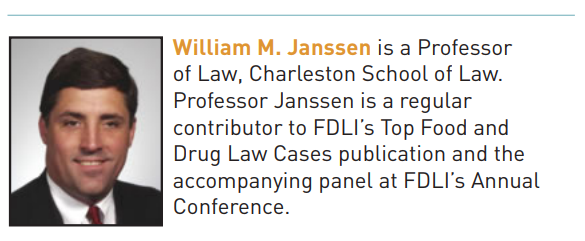
Un-“Stacking” Class Actions
by William M. Janssen 
Statutes of limitation go back a long time. Less than twenty years after the U.S. Constitution was ratified, Chief Justice John Marshall wrote dismissively that it would be “utterly repugnant to the genius of our laws” to accept that a legal action could be “brought at any distance of time.”1 This settled acceptance of limitation periods can be traced to English tradition, which itself has a legislative lineage dated to the 1500s and 1600s.2 But the notion of capping a right-to-sue has origins reaching far earlier, back thousands of years before the English statutes. The Old Testament Book of Deuteronomy, for instance, prescribed that certain debts must be canceled at the end of seven years.3
Today, it is imprinted in American law that “the right to be free of stale claims in time comes to prevail over the right to prosecute them.”4 The rationale most often incanted for this principle is that capping the right-to-sue “promote[s] justice by preventing surprises through the revival of claims that have been allowed to slumber until evidence has been lost, memories have faded, and witnesses have disappeared.”5 But the principle was not chiseled in stone. The law recognizes exceptions. One applies to class actions. Since the 1970s, the U.S. Supreme Court has acknowledged an equitable exception to statutes of limitation for members of putative federal class actions: while such a class action is pending, the applicable limitation period is (usually) “tolled” (or “suspended”). This temporary interruption of the running of a statute was adopted to help ensure that members of the class will have enough time to file their own claims independently, should the court ultimately refuse to certify the proposed class.
For years, a creative extension to this exception had been percolating among the lower federal courts. May a class member, once certification is denied, rely on this tolling exception to file a new proposed class action (rather than just her own, personal claim)? In other words, can a member of a proposed class action wait on the sidelines as that earlier lawsuit is underway, let the statute of limitations expire on her own claim for relief, then, if that earlier lawsuit is refused class treatment, rely on the tolling exception to take a second (or third, or fourth, or fifth) crack at representing that same class in court? In June 2018, the Supreme Court said no. That ruling has important ramifications in food, drug, device, biologics, and tobacco litigation.
A Quick Primer on the Class Action Tolling Exception
Among the principal goals of the federal class action procedure are efficiency and economy of litigation.6 Unlike other litigation procedures, class actions are designed to afford representation not just to those who participate actively in the litigation (or even just to those who are aware that the litigation is occurring), but also to all absent members of the proposed class as well.7 Once the lawsuit is commenced, and as everyone awaits the court’s decision whether to certify the case as a class action, the unnamed class members “are mere passive beneficiaries of the action brought in their behalf.”8 But all the while, the limitations period could be ticking away. If, for example, the court were to deny class action treatment, but do so only after mulling over the issue for many months, the class treatment option would be gone and, with it perhaps, the ability of the class members to press their own timely claims for relief. Waiting for the class action to efficiently and economically vindicate their rights may have inadvertently rendered the class members’ own, individual claims untimely and, thus, extinguished.
To ward off that outcome, members of the proposed class could file motions to join or intervene as named parties in the pending class action lawsuit as an anticipatory, protective measure. But those sorts of filings were the very type of “multiplicity of activity” that the efficiencies and economies of federal class actions were “designed to avoid.”9 To forestall such unnecessary, cumbersome protective maneuvers, the Supreme Court in 1974 in American Pipe and Construction Co. v. Utah embraced a class action “tolling” exception: “[T]he rule most consistent with federal class action procedure must be that the commencement of a class action suspends the applicable statute of limitations as to all asserted members of the class who would have been parties had the suit been permitted to continue as a class action.”10 A decade later, the Court in Crown, Cork & Seal Co. v. Parker extended this tolling to encompass class members who desired to file their own separate, independent lawsuits (rather than just joining or intervening in the pending one).11
This tolling exception, reasoned the Court, aligned nicely with (rather than undermined) the Nation’s well-engrained respect for the policies behind statutes of limitation. If caps on a right-to-sue are designed to prod claimants into prompt action while evidence, memories, and witnesses are still fresh, a class action tolling exception would respect all of that: the timely filing of the proposed class action will have placed the defendants on due notice—within the limitations period—of the substantive claims against them and of their plaintiff accusers, while tolling will ensure that all those encompassed within the proposed class can litigate their timely-filed claims to resolution, either within the class procedure (if class certification is granted) or individually (if class certification is denied).12
The Nation Divides on Using Tolling to “Stack” Class Actions
After American Pipe and Crown, Cork & Seal, the class action tolling exception seemed settled: members of proposed class actions were not induced to file “protective” lawsuits to ensure that, if class certification were denied, they could still timely press their own, individual claims. The tolling exception would protect the timeliness of those claims—provided, of course, the claimants moved promptly once the class certification denial was announced.
The idea of re-purposing this tolling exception to permit claimants to file a subsequent new class action—rather than just their own, individual claims—quickly acquired a devoted following and a vibrant nomenclature (“stacking” class actions, or “serial,” “follow-on,” or “piggybacked” classes). Proponents reasoned that the right to “stack” class actions followed inexorably from the rulings in American Pipe and Crown, Cork & Seal: those decisions preserved the timeliness of a federal claim for relief, and the owners of such claims for relief ought to be able to pursue them with the same array of options that the Federal Rules of Civil Procedure afforded any other litigant. And that included Rule 23 class actions. Proponents relied, in part, on recent Supreme Court language that had pronounced that the federal class action rule applies “automatically” in all federal civil actions, so long as the Rule 23 prerequisites are satisfied.13 This argument proved to be a nationally controversial one.
By 2018, the federal courts of appeals had become sharply divided on the question. The Sixth and Ninth Circuits agreed that the American Pipe / Crown, Cork & Seal class action tolling exception permitted claimants to “stack” class actions (that is, to invoke that tolling exception to make timely what would otherwise have been a time-barred class action complaint). The First, Second, Fifth, and Eleventh Circuits rejected that view, holding that “stacking” was not permitted. The Third Circuit followed a hybrid approach, rejecting “stacking” if the class certification had originally been denied due to a defect with the contemplated class itself, but permitting “stacking” if the original denial was instead based merely on a deficiency of the proffered class representative.14 Into this fray the Supreme Court entered by granting certiorari in China Agritech, Inc. v. Resh.15
The Court in China Agritech Rejects “Stacking”
The China Agritech dispute was a securities fraud fight. A first class action complaint on behalf of certain purchasers of the company’s stock was filed in Los Angeles in 2011, at the very beginning of the claim’s two-year statute of limitations. Fifteen months later, the trial court denied class certification, concluding that the plaintiffs had not established that the company’s stock traded in a manner that could permit classwide treatment. A second class action complaint (substantively identical to the first) was filed a few months later, still within the statute of limitations, but it, too, was denied class certification, this time for failing to meet the typicality and adequacy prerequisites to any federal class. A while later, a third class action complaint (also substantively identical to the first two) was filed, but this time the filing came nearly a year and a half after the statute of limitations had expired. The newest class representative argued, however, that the earlier class actions had tolled the applicable limitations period, thus allowing him to bring his still-timely claim, one he now proposed to litigate as a class action. The trial court dismissed this third action as time-barred; the Ninth Circuit reversed.16 Justice Ginsburg wrote for an 8-1 majority.
Justice Ginsburg wrote for an 8-1 majority. The Supreme Court sided with the no-“stacking” camp: “Time to file a class action falls outside the bounds of American Pipe.”17 The Court explained that the goals of efficiency and economy of litigation impel the conclusion that claimants who wish to proceed as class representatives must make that intention known “early on, soon after the commencement of the first action seeking class certification.”18 Determining whether a particular class should be certified or not is a decision that the Federal Rules of Civil Procedure direct be made at “an early practicable time” after filing.19 At that point, all “dueling” class reps can appear before the presiding trial judge who, aided by those competing suitors’ filings, can most ably decide “whether class treatment is warranted, and if so, which of the contenders would be the best representative.”20 If, after considering the full array of advocates and proposals, the trial judge resolves that class treatment is not “a viable option” for the dispute, that decision is “made at the outset of the case, litigated once for all would-be class representatives.”21
A contrary conclusion, reasoned the Court, “would allow the statute of limitations to be extended time and again; as each class is denied certification, a new named plaintiff could file a class complaint that resuscitates the litigation.”22 While some statutes supply a fixed, outer repose deadline that would restrain such resuscitations, most do not.23 Thus, the practical consequence of serial “stacking” of class actions could transform a two-year statute of limitations into a nearly boundless time to sue. The decisions in American Pipe and Crown, Cork & Seal, the Court explained, were designed to preserve the timeliness of individual class members’ claims as they waited out the trial judge’s decision on whether to certify a class. Those decisions were not envisioned to provide “[e]ndless tolling of a statute of limitations.”24
How Tolling Appears to Function, After China Agritech
The Federal Rules of Civil Procedure permit litigants to propose class action treatment for their claims, provided that proposal is filed timely. The class tolling exception remains in place. Claimants do not need to file their own, personal lawsuits while a proposed, timely-filed class action encompassing their claims is pending. That pending class action will suspend the running of the statute of limitations on all individual claims falling within the proposed class.
What happens if the trial judge denies class certification? A new class action can be filed to replace the one that failed, but only if the new one is itself timely. In calculating that timeliness, the pendency of the original, unsuccessful class action will not have altered the ticking of the limitations clock. (“What the Rules do not offer is a reason to permit plaintiffs to exhume failed class actions by filing new, untimely class claims.”25) So, if multiple claimants propose to vie to represent the class, they must be mindful of that ticking clock. “The plaintiff who seeks to preserve the ability to lead the class—whether because her claim is too small to make an individual suit worthwhile or because of an attendant financial benefit—has every reason to file a class action early, and little reason to wait in the wings, giving another plaintiff first shot at representation.”26
Apart from the prospect of “follow-on” class actions (and the now more sharply fixed deadlines for filing them), the timeliness of the individual, personal claims of members of that putative, now-defeated class remains protected. Individual claimants can file motions to join or intervene into the pending lawsuit, or they can file their own, separate lawsuits.27 But, even here, they must act expeditiously. The running of the statute of limitations on those individual claims is suspended only while the class lawsuit is pending; it re-starts as soon as class certification is denied.28 (More precisely, it re-starts as soon as class certification is denied in the last timely-filed class action lawsuit, if multiple, timely class actions have been filed.29) Thus, if the unsuccessful class action lawsuit was filed on the very day a two-year statute of limitations began to run, the individual claimants will have two years from the date of the class certification denial to pursue their own, personal claims. If, however, the class action lawsuit was filed with only eleven days remaining on the statute, the individual claimants will have only those remaining eleven days to act.30
Implications for Food, Drug, Device, Biologics, and Tobacco Litigation
A large sector of the food, drug, device, biologics, and tobacco civil litigation docket is products liability and, to be sure, the conventional wisdom is that personal injury claims in that context are often ruled inappropriate for class certification.31 Such lawsuits frequently fall within the scope of Rule 23(b)(3), which requires that common questions of law or fact “predominate over any questions affecting only individual members” and that class treatment be “superior to other available methods for fairly and efficiently adjudicating the controversy.”32 Individual injury claims often founder against that inquiry.33 But not always. There is no categorical, all-encompassing prohibition against class certification that forecloses the procedure in every imaginable sort of products claim.34
Moreover, though large, the products sector is not the only litigation type in the docket. Trade practice injury, consumer protection, and securities violation claims represent a sizable volume in this litigation space.35 As to those claim categories, showing the requisite predominance to warrant class treatment is more likely.36
For both reasons, and others, the China Agritech prohibition on using tolling principles to “stack” untimely class actions is likely to have important reverberations in food, drug, device, biologics, and tobacco litigation. It is true that this prohibition is unlikely to affect most serious injury claims (because those are likely to remain individual litigations by choice or necessity). For this reason, the well-placed concern that the “stacking” ban could disproportionately impact negative-value claims and claims by unmotivated or resourceless individuals is not likely to be present in any serious injury docket. Elsewhere, however, the prohibition will have ramifications. The prohibition will help to ensure that the long-settled policies behind capping the right-to-sue (locatable evidence, fresh memories, available witnesses, finality and repose) are realized by incentivizing the early filing of class actions. It will also likely encourage more crowded, animated contests at the outset of class litigation for the right to serve as class representative and class counsel. It may even trigger “protective” class action filings, as a failsafe recourse if post-denial applications for amendment or joinder are not liberally welcomed. This much, though, is certain: the China Agritech decision has achieved what triggered the grant of certiorari in the first place. There is now a uniform, national answer to the “stacking” question; the inter-Circuit division on the question is ended.
Update Magazine
December 2018/January 2019
- Adams v. Woods, 6 U.S. (2 Cranch.) 336, 342 (1805) (“In a country where not even treason can be prosecuted after a lapse of three years, it could scarcely be supposed that an individual would remain forever liable to a pecuniary forfeiture.”).
- See Gail L. Heriot, A Study in the Choice of Form: Statutes of Limitation and the Doctrine of Laches, 1992 B.Y.U. L. Rev. 917, 923-27 (1992) (recounting English foundations).
- Deuteronomy 15:1-3 (“At the end of every seven years you must cancel debts. This is how it is to be done: Every creditor shall cancel any loan they have made to a fellow Israelite. They shall not require payment from anyone among their own people, because the LORD’s time for canceling debts has been proclaimed. You may require payment from a foreigner, but you must cancel any debt your fellow Israelite owes you.”). See generally Morris Jastrow,
Jr., S.R. Driver, Emil G. Hirsch, & Benno Jacob, Deuteronomy: Age and Authorship of Deuteronomy, Jewish Encyclopedia (1906) (“It is the unanimous opinion of modern critics that Deuteronomy… was, in its main parts, written in the seventh century B.C….”), available at http://jewishencyclopedia.com/articles/5132-deuteronomy#anchor9. - Order of R.R. Telegraphers v. Ry. Express Agency, 321 U.S. 342, 349 (1944).
- Id. at 348-49.
- See Am. Pipe & Const. Co. v. Utah, 414 U.S. 538, 553 (1974).
- See Fed. R. Civ. P. 23(a) (permitting “[o]ne or more class members” to litigate “on behalf of all members”).
- American Pipe, 414 U.S. at 552.
- Id. at 551.
- American Pipe, 414 U.S. at 554.
- 462 U.S. 345, 350-54 (1983).
- Id. at 550-55. See also Crown, Cork & Seal, 462 U.S. at 352-53.
- See Shady Grove Orthopedic Assocs., P.A. v. Allstate Ins. Co., 559 U.S. 393, 400 (2010).
- See China Agritech, Inc. v. Resh, __ U.S. __, 138 S. Ct. 1800, 1805-06 (2018) (summarizing decisions among federal courts of appeals).
- __ U.S. __, 138 S. Ct. 1800, 1805-06 (2018).
- See id. at 1804-06 (recounting procedural history).
- Id. at 1811.
- Id. at 1806.
- See Fed. R. Civ. P. 23(c)(1)(A).
- China Agritech, 138 S. Ct. at 1807 & 1810-11.
- Id. at 1807.
- Id. at 1808.
- Id. at 1808-09.
- Id. at 1809. The sole objecting voice was Justice Sotomayor’s, who concurred in the Court’s judgment. She wrote that while the Court’s no-“stacking” rule was appropriate given the peculiarities of the federal securities fraud statutory regime, a blanket no-“stacking” rule in other litigation contexts was, she thought, unwarranted. Id. at 1811-15 (Sotomayor, J., concurring in result).
- China Agritech, 138 S. Ct. at 1811. In her concurrence, Justice Sotomayor advocated for trial judges to “mitigate the potential unfairness” of the Court’s no-“stacking” rule by “liberally permit[ting] amendment of the pleadings or intervention of new plaintiffs and counsel,” where appropriate, to preserve an otherwise deficient class action. Id. at 1815 (Sotomayor, J., concurring). Whether the Majority approves such an admonition is unclear.
- Id. at 1810-11.
- See Crown, Cork & Seal, 462 U.S. at 354.
- China Agritech, 138 S. Ct. at 1809.
- Id. at 1805 (“Because the Smyth litigation [the second of the two timely-filed class actions] was timely commenced, putative class members who promptly initiated individual suits in the wake of the class-action denial would have encountered no statute of limitations bar.”).
- See American Pipe, 414 U.S. at 542 & 561 (class lawsuit filed with 11 days remaining on the statute of limitations; individual claimants acted timely because they filed 8 days after certification was denied). See also Crown, Cork & Seal, 462 U.S. at 354 (class lawsuit filed before claims of individual claimants had even accrued; individual claimants acted timely because, once certification was denied, they filed within their limitations period).
- See generally In re Rezulin Prod. Liab. Litig., 210 F.R.D. 61, 65–66 (S.D.N.Y. 2002) (collecting cases, observing that “all relevant Court of Appeals and the bulk of relevant district court decisions have rejected class certification in products liability cases”) (footnotes omitted).
- Fed. R. Civ. P. 23(b)(3). See generally Amchem Prod., Inc. v. Windsor, 521 U.S. 591, 623 (1997) (“predominance inquiry tests whether proposed classes are sufficiently cohesive to warrant adjudication by representation”).
- See generally Amchem Prod., Inc., 521 U.S. at 623–25 (discussing the number and significance of member-peculiar questions in asbestos products litigation, and quoting Rule 23’s Advisory Committee Note that such cases are “ordinarily not appropriate” for class treatment).
- See id. at 625 (“Even mass tort cases arising from a common cause or disaster may, depending upon the circumstances, satisfy the predominance requirement,” noting that the text of Rule 23 “does not categorically exclude mass tort cases from class certification, and District Courts, since the late 1970’s, have been certifying such cases in increasing number”).
- See, e.g., Lambert v. Nutraceutical Corp., 870 F.3d 1170 (9th Cir. 2017) (consumer fraud and unfair trade practices); North Sound Capital LLC v. Merck & Co., 314 F. Supp. 3d 589 (D.N.J. 2018) (securities fraud).
- See id. (“Predominance is a test readily met in certain cases alleging consumer or securities fraud or violations of the antitrust laws.”).






